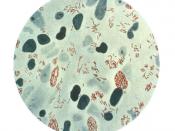Leprosy
Definition
Leprosy is a slowly progressing bacterial infection that affects the skin, peripheral nerves in the hands and feet, and mucous membranes of the nose, throat, and eyes. Destruction of the nerve endings causes the the affected areas to lose sensation. Occasionally, because of the loss of feeling, the fingers and toes become mutilated and fall off, causing the deformities that are typically associated with the disease.
Description
Leprosy is also known as Hansen's disease after G. A. Hansen who in 1878 identified the bacillus Mycobacterium leprae that caused the disease.
The infection is characterized by abnormal changes of the skin. These changes, called lesions, are at first flat and red. Upon enlarging, they have irregular shapes and a characteristic appearance. The lesions are typically darker in color around the edges with discolored pale centers. Because the organism grows best at lower temperatures the leprosy bacillus has a preference for the skin, the mucous membranes and the nerves.
Infection in and destruction of the nerves leads to sensory loss. The loss of sensation in the fingers and toes increases the risk of injury. Inadequate care causes infection of open wounds. Gangrene may also follow, causing body tissue to die and become deformed.
Because of the disabling deformities associated with it, leprosy has been considered one of the most dreaded diseases since biblical times, though much of what was called leprosy in the Old Testament most likely was not the same disease. Its victims were often shunned by the community, kept at arm's length, or sent to a leper colony. Many people still have misconceptions about the disease. Contrary to popular belief, it is not highly communicable and is extremely slow to develop. Household contacts of most cases and the medical personnel caring for Hansen's disease patients are not at...


